by Mike Gulett –
The Isetta is physically a small car but as an idea and a design concept it had a big impact on the automobile industry. Conceived and developed by the Italian motor scooter and motorcycle company, Iso, it was a brilliant idea whose time had come. It continues to influence the automobile industry even today nearly 65 years after it was first introduced in November 1953 at the Turin Auto Show. The motoring press had never seen a car like the Isetta and they loved it, after they got over the shock of such an unusual looking car.
Renzo Rivolta was a genius who does not get all of the credit he deserves. After WW II he saw the need to provide low cost transportation to Italians and other Europeans. He began manufacturing motor scooters and later small displacement motorcycles. This was successful for Iso so Rivolta was inspired to move into the automobile business and the Isetta was the first Iso automobile.
The British car publication, Motor wrote about the Iso Isetta on September 22, 1954,
“…the Isetta is boldly unconventional vehicle which fulfills two main purposes. It provides transportation of a kind, which is cheaper than conventional motoring but more comfortable by far than motorcycling.
The basic difference between the Isetta and any other vehicle is that the entry is from the front in the manner of the hansom cab, instead of being from the side as is nowadays usual.”
The Isetta is a ground breaking design that was created by new engineers hired by Rivolta for that purpose. One of the characteristics that made Renzo Rivolta a genius was his ability to hire the best people for the job and this certainly is the case for the Isetta team he hired.
These engineers had not worked in the Iso business of scooters and motorcycles or the older Iso predecessor business, the Isothermous refrigeration business.
Aeronautical Engineers
These new engineers were: Ermenegildo Preti (an aeronautical engineer and a professor at Milano Politecnico) and Pierluigi Raggi (also an aeronautical engineer).*
Renzo Rivolta and Ermenegildo Preti came up with this basic idea separately; Preti called it the ‘city car’ by which he meant, a car designed to be easy to use in congested cities, not for long road trips (perhaps the first car intended for such a purpose). Preti and Raggi supplied the brilliant details of the Iso Isetta design and function.
The Door
Ermenegildo Preti arrived for his interview with Renzo Rivolta in 1952 with a wooden mock up model of the ‘city car’.** This model had the now famous front opening door of the Isetta. Contrary to urban legend this door had nothing to do with Iso’s previous refrigerator business. Preti had not worked in the refrigerator, motor scooter or motorcycle business but came to Iso directly from the aeronautical industry and academia.* His concept for the ‘city car’, which became the Isetta were unique to him and he applied for patents on this design in 1950 and Iso applied for patents on some of these design ideas in 1952.**
The one door on the Iso Isetta opened from the front, like a hansom cab, as noted by some journalists at the time. This unique door allowed the Isetta to park nose first toward the sidewalk and the door would open with the steering wheel moving out of the way so that the occupants could step right out onto the sidewalk. An Isetta took up much less space parked on the street than any conventional car and was shorter than the width of a typical American car.
There were two rear wheels, which were very close together eliminating the need for a differential and thus saving expense and weight. The engine used was the Iso two stroke, single cylinder 198 cc motorcycle engine with the twin piston design producing 9.5 hp. This engine was placed behind the occupants so that an engine bonnet did not obstruct the view out of the front, allowing the entire front of the car to be the door.
Iso Isetta Production Begins
The first Iso Isettas came off the production line in April 1953.
The Isetta was certainly an unconventional car but it won widespread appraisal when tested.
Torino Motori tested one of the prototypes in late 1952 and wrote,
“It is important,” the magazine stated, noting Iso’s approach to motoring for the masses, “to understand that this little car defined as ‘the winter scooter’, really strays far in general style from the conventional ideas about cars, and achieves a completely new and very original look. People that haven’t been able to afford a car so far due to financial limitation, now find in the Isetta a practical and economical vehicle that can comfortably seat two people on any road in any weather…It is another step toward ‘motorization for everybody’ that is the base for social and economic welfare.”**
In 1954 Iso entered four Isettas in the grueling Mille Miglia (the 1000 mile Italian road race). The four Isettas placed in the top four positions in the “Index of Performance” category which takes into account the car weight, engine size, horsepower, average and top speed plus other items. All four Isettas not only finished the race they beat all others in this category including Ferrari, Maserati and Porsche.
BMW
Even though the Isetta was a desirable car, Iso had difficulty with sales volume. Some journalists say this is because it did not suit the ‘style’ of Italians and maybe because Iso did not have a great dealer and sales system set up. A contributor to slow sales could also have been competition in Italy from Fiat with the 600 and Topolino models. If Iso could not be successful in their home market then they would certainly struggle outside of Italy.
This lack of sales led to Iso licensing the design to several companies including BMW, which sold more than 160,000 Isettas while Iso sold maybe 1,500** on their own. BMW replaced the Iso engine with a BMW motorcycle engine, which provided more power and reliability. Plus the economics favored BMW in using their own engine.
The BMW marketing power combined with the genius of the Isetta design resulted in a great financial success for both Iso and BMW. This arrangement was successful enough to save both BMW and Iso from financial failure. In the case of Iso this was a temporary save but for BMW it allowed them to transform themselves into one of the most important automobile companies in the world.
Summary
Motor concluded in their September 22, 1954 article about the Isetta,
“Boldly and cleverly unorthodox, simple but by no means crude, diminutive but quite good looking, the Isetta may well prove to be pioneering a development as important as that of the motor scooter…
Very obviously, congestion in towns would be eased if a substantial number of orthodox cars could be replaced by vehicles as compact as this, and it may be noted that…the Isetta may often be nosed straight into the sidewalk allowing the passengers to step straight out of the front door onto the pavement.”
The ‘city car’ was a new concept in 1952 and the Isetta demonstrated to the world what a car specifically designed to navigate cities could be. It was economical, small and convenient to drive and park. It started with the idea of two or three passengers riding in enclosed comfort instead of on an open motor scooter. The Isetta is a milestone car.
How many car designers were inspired by the Isetta as an example of what could be done with new, original thinking? Renzo Rivolta and Ermenegildo Preti, both brilliant men, made a significant contribution to the automotive world that is still being felt today.
Let us know what you think in the Comments.
More Iso Isetta photos by Mike Gulett are in the slide show below.
References
* Campetti, Flavio, Da Iso a ISORIVOLTA (Giorgio Nada Editore, 2004).
** Goodfellow, Winston, Iso Rivolta The Men, The Machines (Giorgio Nada Editore, 1995).
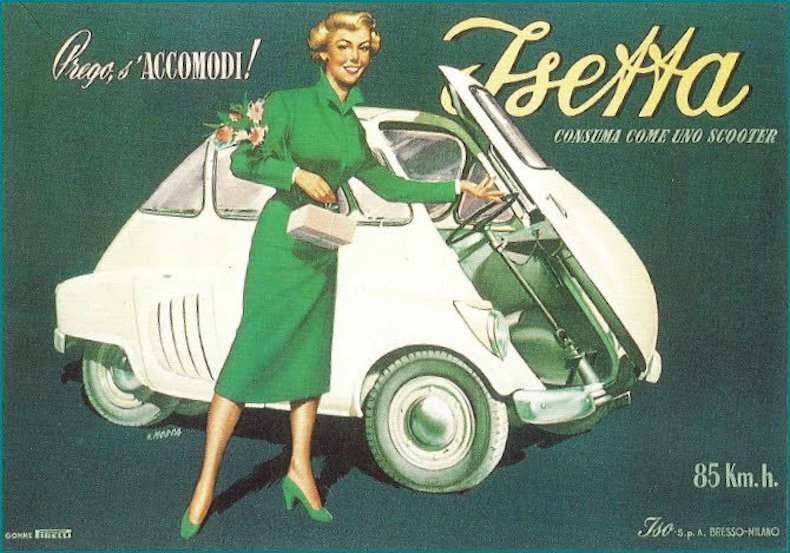
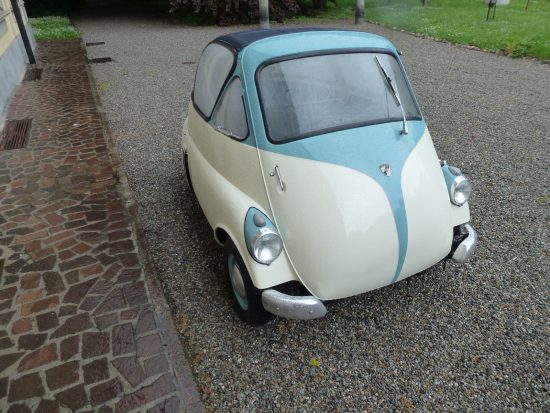
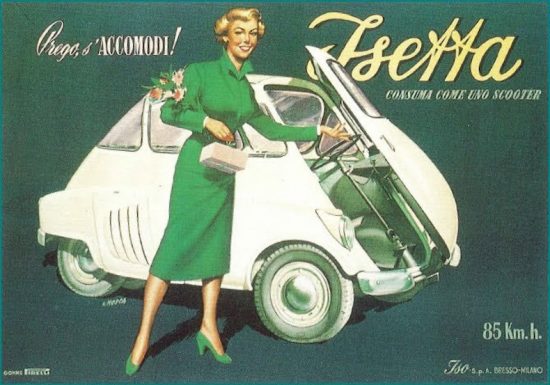
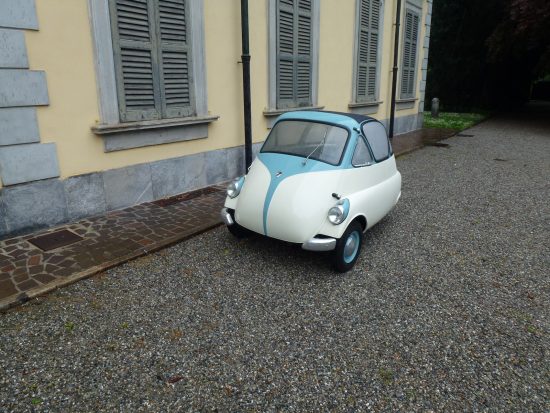
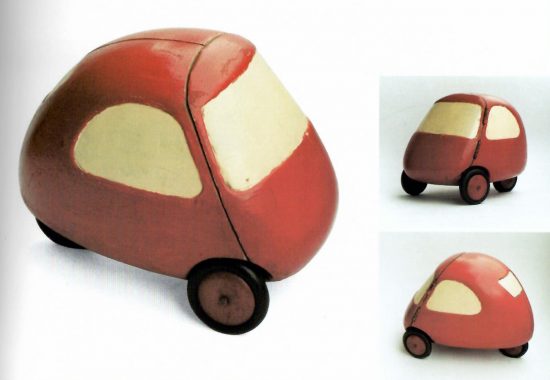
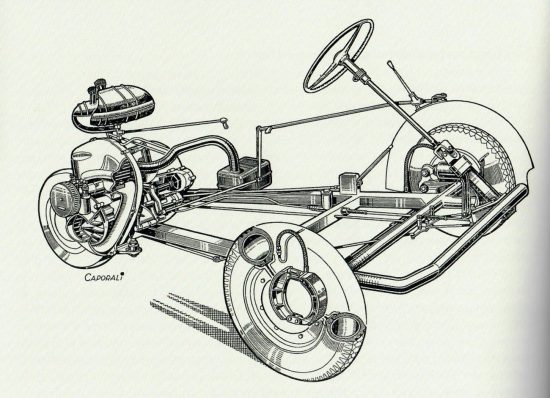
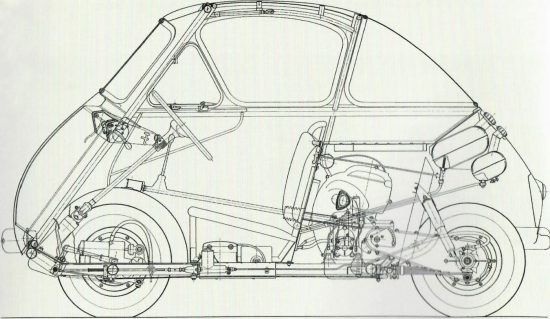
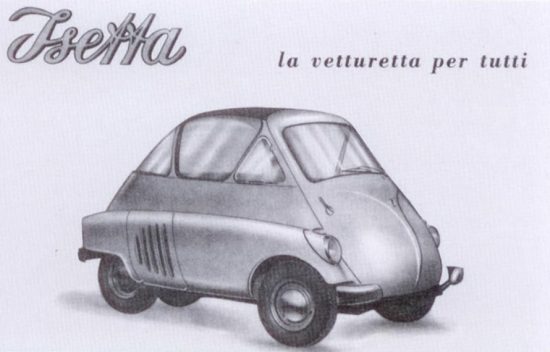
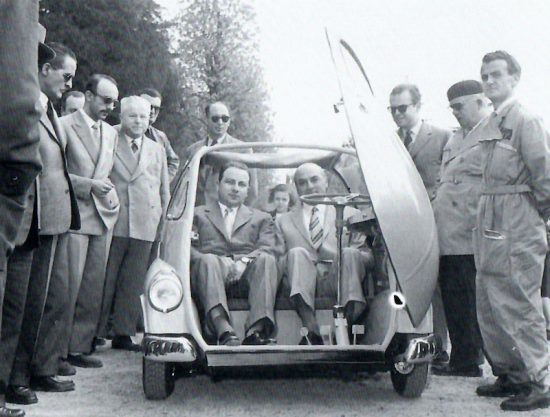
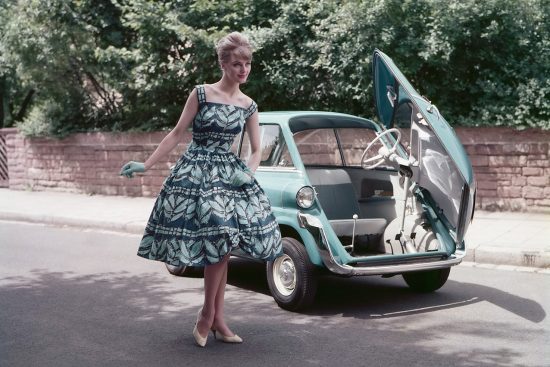
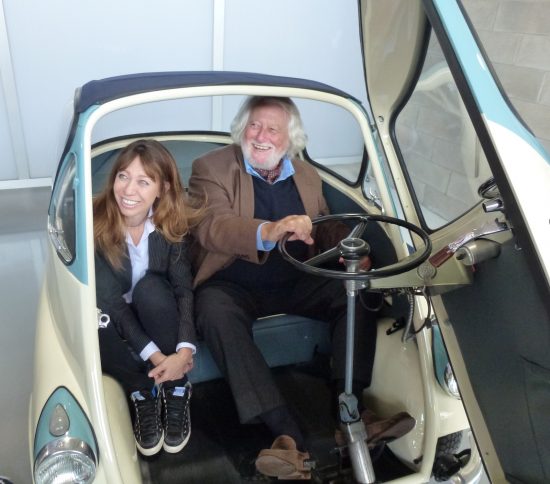




















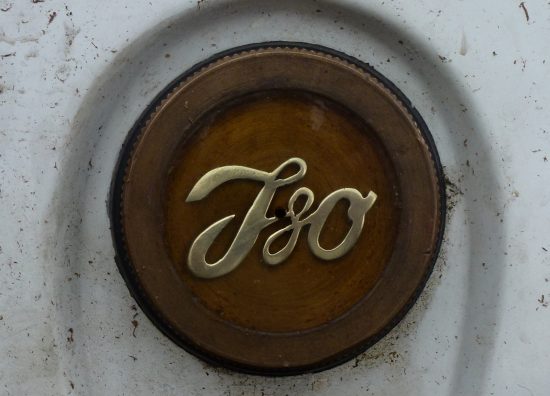
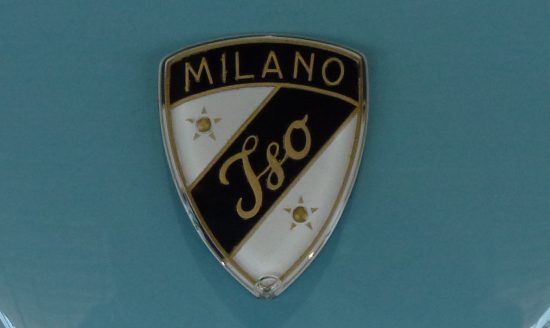


Although maybe new for Europeans in 1952, the Japanese always manufactured Kei Cars/Microcars/City Cars.
Glenn,
Kei cars were not always around. They were created after WWII for the Japan market. While the goal seems similar to the Isetta they were specifically made for the Japan market and did not affect the rest of the world, as far as I can tell, like the Isetta has.
Here is a quote from JAMA, “As a concept, Japan ’s unique breed of kei jidosha (light car) started out back in the ‘50s as a kind of basic, get-you-going form of utilitarian transport.”
Read the article here, http://www.jama-english.jp/europe/news/2005/jan-feb/peternunn.html
Yes, Kei cars were specifically for the Japanese domestic market only (and still are) and did not affect the rest of the world like the Isetta did. However, their purpose was basically the same: a small, basic, inexpensive city commuter car, that would pay a much lower car tax by having an engine less than one liter in size, and provide great fuel economy for an oil-deprived nation. There were also a lot of other German microcars as well, built by Messerschmidt and other German companies after the war, that again, served the same purpose, but did not turn the world on fire like the Isetta did. They all had the same goals to achieve, yet only the Isetta achieved the worldwide acclaim and success, as you say.
Well written article. Nice job.
Apparently a few West Germans were smuggled across the Berlin Wall hiding in the engine compartment of the BMW version of these Isettas . Up to two people would squeeze into the engine compartment of ones driven by legitimate free entry personnel and most guards would not even consider checking that small engine space in the rear .
Wayne,
Interesting story – where did you hear this?
I met some German tourists in Sydney late in 1990 who told me the true story and they even gave me a piece of the wall complete with graffiti and a picture of them chipping away at the wall earlier in the year . I still have both items . At that time I was a volunteer worker at the now defunct Sydney Motor Museum in Harris Street and we had a green RHD version of the BMW that was driven overland from Great Britain to Sydney . The RHD versions are rare now and the front door hinged from the opposite side complete with the movable steering wheel and column allowing passengers to leave the car onto the left hand kerbside . Amazingly enough there was just enough space around the engine to squeeze two Pygmy West Germans in , but it must have been extremely hot and uncomfortable
A real nice story and quite interesting. Not many concepts get to reality with so little changes. A good example of the designers maxim “If it looks right then it is right”.
I have always lusted for one of these ever since I saw one around ’59 – ’62.
There was a red and white one (they all seemed to be those colors) near my high school.
We, some friends and myself, walked past it a lot on our sojourn around the neighborhood each Friday.
Someone said that he bet he could lift its front end. He did, and then we all lifted it together, one at each corner.
Well, that that not being satisfying enough (excuse the youthful exuberance taken) someone said; he wondered if it would fit on the porch three steps up, so….it did… Late apology to you sir, whomever you were.
No, no damage done, really, and it was down the next day.
Did you see the “Pickers” show where they came across a fellow and his wife that had an amazing collection of Micro cars, among which was a couple on the later series.
Mike got a amazing deal ($11k) for one that the guy really dressed up and even did the brakes. He stole that car, and had to think about it first.
Raymond,
You are your friends must be well remembered by the whole neighborhood.
Visit isetta world, the Facebook page of the Isetta Owners Club of GB http://www.facebook.com/groups/267159327250111/